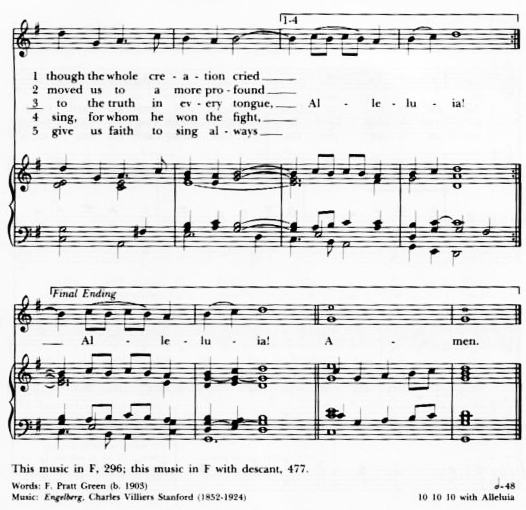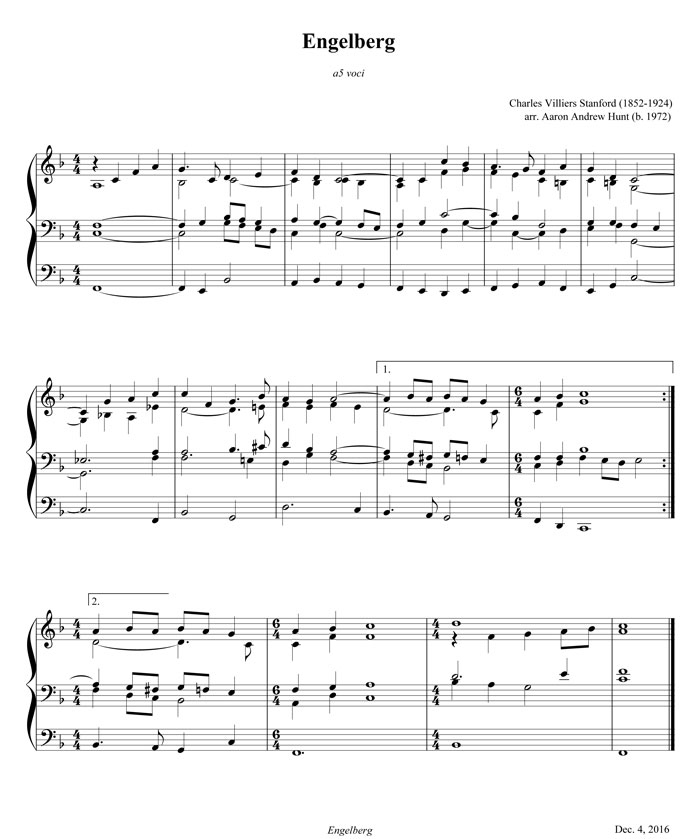

Rewriting Annoying Music - Engelberg by Charles Villiers Stanford
December 04, 2016
Charles Villiers Stanford (1852-1924) was born in Ireland, but lived most of his life in England. He was educated at Queen's College Cambridge and the Royal College of Music, and later was professor of music at the University of Cambridge. Stanford was a gifted composer, and prolific. If you don't know his instrumental music, give it a listen. But he's best known for his contributions to the Church of England. Of his many anthems and hymns, Engelberg is one of the most beloved.
I've always liked this tune. So what annoys me about it? Well, it's not the tune. It's the organ accompaniment as written in The Hymnal 1982. Let's take a look and I'll explain why it bothers me.
Engelberg


The structure of the hymn is 10 10 10 with Alleluia. It works with several other texts, but is best known by the one shown here, When in Our Music God is Glorified, by Fred Pratt Green.
Most hymns are written in four parts, SATB harmony. Not this hymn. SATB hymns, when written well, always sound solid and consistent. As an organist and a composer, I want to see and hear and feel that kind of solidity and consistency in the music I'm playing, and if there is a change in the texture, I want to see and hear a good reason for it. Did you notice that the number of voices is not consistent? Look at how widely the texture fluctuates. This is the first thing that bothers me about this music.
Texture




So what do we have here? We start with 6 voices, then move to 5. Then we alternate between 5 and 4 … can't figure out what we want … and then we have the same indecisiveness between 5 and 6 voices. Finally, at the big finish, we have a whopping 7 voices. Are there good reasons to change the texture so often? I think not. Remember, octave doublings are basically not necessary in organ music; that's what registration is for. With proper registration, fewer voices is actually better.
This is not the only thing that's troublesome about this music. Can you guess what the next issue is? There are problems. Look closely.
Voice Leading

That's right. The dreaded parallel octave. The second system is okay.

The third and fourth systems are the most offensive.


The octave doublings are obviously done to try to deliver more powerful music, but on the organ that is not necessary.
My Arrangement
Because I really do like this music, I decided to fix what's wrong with it and write a version for myself that I could enjoy playing.
A Hymn should really not need to have more than four parts, but let's be open to the idea of a hymn harmonized for more than 4 voices. After all, 5 voice counterpoint can sound great when it's done right. Based on Stanford's original, I decided that the number of voices needed to basically maintain his intention is 5. I didn't substantially change any harmony, only improved the voiceleading, added a few suspensions and strengthened a few places with neighbor tones. The outer voices remain identical to Stanford's original. Here is my arrangement.

Here is a recording of myself playing through this one time, slowly (without the Amen ending).
If you enjoyed this entry, you may be interested in reading past episodes of Rewriting Annoying Music.
Best Regards,
Aaron
P.S. I didn't point out one of the parallel octaves Stanford wrote, and I left in my arrangement. Can you find it? (Hint: it appears twice)
[ Showing 1 entry | Previous entry | Next entry | Show all entries ]